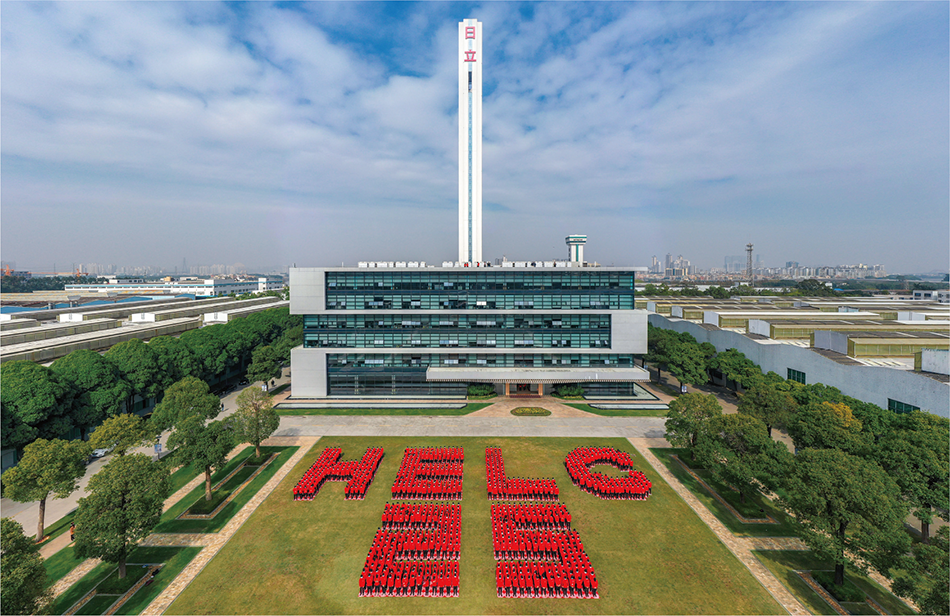COVER STORY:GLOBAL INNOVATION REPORTContribution to China’s Green Manufacturing System and Work toward Achieving Carbon NeutralityEnvironmental Initiatives at Hitachi Elevator (China) Group
Highlight
In its Hitachi Environmental Innovation 2050, Hitachi Group has set long-term targets based on a vision for the environment that seeks to realize a decarbonized society, resource-efficient society, and a society harmonized with nature. The Building Systems Business Unit is also playing its part in activities directed at these targets. Meanwhile stakeholder expectations for corporate action on the environment are on the rise in recognition of the crisis in the global environment. In particular, the People’s Republic of China has announced the establishment of a green manufacturing system and Hitachi’s Building Systems Business Unit, which has many production facilities located in China, has been pursuing environmental measures that anticipate this development. This article describes the environmental activities of Hitachi Elevator (China) Co., Ltd., which manufactures elevators in China.

Introduction
The environmental activities of Hitachi’s Building Systems Business Unit involve environmental management for creating a sustainable society and realizing Hitachi’s environmental vision of a decarbonized society, a resource-efficient society, and a society harmonized with nature, primarily at its major production facilities at Mito Works in Japan and the seven factories operated by the Hitachi Elevator (China) Co., Ltd. group of companies in the People’s Republic of China (see Figure 1).
Alongside this, China published its Made in China 2025 plan in 2015, setting out a roadmap to becoming a manufacturing powerhouse. The establishment of the National Green Manufacturing System formed part of this project. Hitachi Elevator (China) Group made a planned entry into the system, obtaining green factory certification for six of its finished-product manufacturing sites in September 2020. This article describes this work together with recent trends and what Hitachi Elevator (China) Group aims to become.
Environmental Activities of Hitachi Elevator (China) Group
Hitachi Elevator (China) was established in 1995 and engages in the research and development, manufacturing, sale, installation, maintenance, and upgrading of elevators, escalators, travelators, and intelligent security systems. The Group has more than 70 branch offices spread across the major cities of China and manufacturing plants in Guangzhou (Guangzhou factory, escalator factory, motor factory, and electrical parts factory), Tianjin, Shanghai, and Chengdu. It is the largest elevator and escalator business in the Hitachi Group with annual production capacity in excess of 120,000 units.
Overview of National Green Manufacturing System
The National Green Manufacturing System project forms part of the Made in China 2025 plan formulated by the Chinese government to boost manufacturing competitiveness.
Green manufacturing is a modern manufacturing model that includes comprehensive consideration of the impact on the environment and efficiency of resource use, without compromising product functions, quality, and cost. Through technological innovation and system optimization, green manufacturing seeks to harmonize and optimize corporate economic and social value, maximizing the efficiency of resource and energy use and minimizing impacts on not only the environment, but also society and human health across the entire product life cycle, including design, production, logistics, use, recovery, disassembly, and re-use.
The National Green Manufacturing System aims to establish green manufacturing systems that are highly efficient, good for the environment, low-carbon, and incorporate recycling. It is divided into four categories (green factories, green products, green industrial parks, and green supply chains), covering companies that seek to become leaders in global markets and model green manufacturers able to serve as benchmarks for their industries(1).
Of these, green factories are defined as factories that feature intensive land use, non-harmful raw materials, clean production, waste recycling, and low-carbon energy while also engaging in green manufacturing and placing a high priority on making the shift to green processes. Certification is obtained by means of a third-party assessment and auditing by the Ministry of Industry and Information Technology based on the requirements specified in the General Principles of Green Factory Assessment (GB/T 36132-2018) (see Table 1).
Similarly, the green supply chain concept refers to spreading consideration for environmental protection and resource efficiency to all steps along the supply chain. Along with harmonizing corporate economic activity and environmental protection across all processes from product design, materials procurement, production, transportation, warehousing, sale, use, and disposal and increasing the efficiency of resource use by both upstream and downstream companies to improve their environmental performance, green supply chains also aim to make the companies in the supply chain greener by getting them to use resources more efficiently and minimize the load they place on the environment. Certification is obtained by means of a third-party assessment and auditing by the Ministry of Industry and Information Technology based on the requirements specified in GB/T 33635-2017, China’s standard for Green Manufacturing – Green Supply Chain Management in Manufacturing Enterprises – Guideline (see Table 2).
The following sections describe what Hitachi Elevator (China) Group did to acquire green factory and green supply chain certification.
Table 1 | Requirements and Evaluation Criteria under China’s General Principles of Green Factory Assessment (GB/T 36132-2018)
Table 2 | Requirements and Evaluation Criteria for Green Supply Chain Management
Benefits of Green Manufacturing at Hitachi Elevator (China) Group
Alongside improving economic efficiency, Hitachi Elevator (China) Group has also for many years placed a top priority on relationships in which the environment and society are in harmony, holding to its philosophy of achieving a win-win coexistence between society and the environment. It has remained one of the leading companies in the industry, actively participating in green activities such as environmental protection, energy efficiency, decarbonization, and waste reduction in the supply chain.
Hitachi Elevator (China) has expanded its environmental protection activities, combining protection of the environment with productivity as it has gone about the ongoing optimization of green production, selection of green raw materials, enhancement of product energy efficiency, adoption of green packaging, and improvement of installation practices. It has established a green supply chain management system and built production systems that use green manufacturing through the computerization of its factories and the adoption of smart practices. The following are some examples.
- Formulation of environmental action plan
Focusing on energy efficiency, environmental protection, decarbonization, and efficiency improvement, an environmental action plan was formulated for the four issues of governance, a decarbonized society, a resource-efficient society, and a society harmonized with nature. Furthermore, environmental protection and green activities are being treated as important challenges by formulating annual plans for investment in energy-efficient equipment based on the circumstances at the time to align management thinking and by assigning responsibilities. - Use of green materials
Work is proceeding on the management of green products and the establishment of production systems by using materials that take account of the environment in manufacturing processes. A lot of effort is also going into reducing or replacing harmful raw materials or other supplies. Discharges of volatile organic compounds (VOCs) and other pollutants have been reduced over recent years through a shift to low- or non-toxic materials in the selection of raw materials and other supplies. For coating processes, this has involved the use of electrodeposition, the replacement of oil-based with water-based paints, and a switch to powder coatings that do not contain VOCs. For welding, it has included the adoption of alcohol no-wash welding. - Adoption of green manufacturing
Hitachi seeks to use green manufacturing and green production for its products through the adoption of energy-efficient equipment and green production practices in its manufacturing processes.
One example is the use of inverter control with low energy consumption in air conditioning systems together with centralized control. Inverter control is also used for air compressors and pumps.
Water re-use is another priority, and the efficiency of water use has been increased and use of the public water supply reduced through the upgrading of existing wastewater treatment systems. This has included retrofitting them with greywater recycling, recycling the wastewater from the production of clean water for manufacturing, and filtration equipment for recycling water used in ponds or for other decorative purposes. One example is how most of water used in production processes at the Shanghai plant is treated and re-used on the production line or in toilets, gardens, or the decorative pond located on-site (see Figure 2).
Likewise, advanced techniques are used on the coating line. Use of electrodeposition for the base coat has improved the adhesion of subsequent coatings. Similarly, VOC discharges have been cut and residues reduced by about 70% by switching to powder coating for the standard-color top coats. - Improvements to environmental performance of products
For the products themselves, Hitachi is pursuing weight reduction, the reduced use or replacement of harmful substances, and the efficient recycling of parts. In terms of the product lifecycle, Hitachi also considers how to achieve low carbon emissions at each step, from parts and materials procurement to manufacturing, logistics, disposal, and recycling. It is currently conducting product lifecycle assessments for its main elevator and escalator models, receiving an A rank in a certification audit of energy consumption by the German certification agency Technischer Überwachungsverein (TÜV).
Product development by Hitachi Elevator (China) is targeting things like improved energy efficiency, space efficiency, and operational efficiency through such technologies as energy regeneration, electromagnetic compatibility (EMC), weldless elevator car frames, permanent magnet synchronous motors, and group elevator control with a floor reservation function. - Use of green packaging
Improvements have also been made to the materials and practices used for product packaging, with a 20% reduction in the use of wood compared to 2014 (prior to the project starting). Use of plastic sheet has also been reduced. In addition to cutting costs, this has improved productivity by shortening the amount of time spent on packing. The new improved packaging also features better packaging quality and ensures protection for the product (see Figure 3). - Optimization of product installation
For elevator installation, Hitachi has switched to a better scaffold-free working practice that it developed for itself to enable more efficient and high-quality installation. The benefits of adopting this practice include saving on the fuel used for delivering scaffolding pipes (see Figure 4). - Green supply chain management
By taking the lead in teaming up with suppliers, logistics operators, sales agents, and end users on initiatives that include improving material selection and working practices, installing automated and energy-efficient equipment, and putting green logistics, after-sales services, and product recovery practices in place, Hitachi Elevator (China) is working to adopt the critical technologies of replacing and reducing harmful substances, designing products that allow for disassembly and remanufacturing, and selecting renewable materials. Hitachi is also strengthening environmental management of suppliers, making use of the waste and byproducts created in supply chain processes and rendering them harmless. Examples include establishing in-house courses in procurement process technology and working with suppliers to explore opportunities for energy efficiency to improve manufacturing practices. Third-party agencies have been engaged to conduct on-site audits of the corporate social responsibility (CSR) of suppliers based on the Hitachi Group manual for CSR procurement in the supply chain. A rule-based approach to evaluating the environmental and social responsibility of suppliers has been established based on internal rules for the assessment of suppliers by the procurement division and instructions for pollution map blacklisting assessment. These rules are regularly updated.
Certification under National Green Manufacturing System
Hitachi Elevator (China) Group has been actively working to realize China’s National Green Manufacturing System ever since it was first formulated, with six of its seven manufacturing facilities having been certified as green factories. Certification of the seventh and final facility is currently in progress. Hitachi Elevator (China) Group has also established a position for itself as an industry leader, having received certification for engaging in green supply chain management.
When its Guangzhou motor factory became the first Hitachi Elevator (China) Group facility to receive green factory certification, it was one of only 27 companies in all of Guangdong Province to have done so(2). The advanced nature of the work being done by Hitachi Elevator (China) is also exemplified by the fact that, at the time of its receiving certification for green supply chain management, there were only 11 other companies in Guangdong Province that had gained the same certification(3).
The certifications received under the green manufacturing system also confer benefits in the form of preferred supplier status on public projects and other government support. Being a certified company is a mark of trustworthiness and enhances competitiveness in the product tendering process by boosting the brand image of Hitachi Elevator (China) and making its name more well known. It has also provided the opportunity to receive CNY600,000 to CNY1,000,000 in grants (see Figure 5).
Figure 5 | Certification as Green Factory (left) and Company Certification for Green Supply Chain Management (right)
Future Plans
Hitachi Elevator (China) is running an energy efficiency project and installing photovoltaic power generation to achieve Hitachi Carbon Neutrality 2030, Hitachi Group’s plan to reduce emissions of carbon dioxide (CO2) from its factories, offices, and other workplaces by a net 100% relative to emissions in 2010.
- Energy efficiency project for reducing CO2 emissions
Hitachi Elevator (China) Group has been running an energy efficiency project since 2011. The various measures have reduced CO2 emissions by 4,788 t, equivalent to 16% of emissions in the baseline year (2010). Although the number of units produced increased by a factor of 2.4 over this time, from approximately 50,000 in 2010 to 120,000 in 2020, the improvements in production efficiency limited the increase in CO2 emissions to only 9%.
The main actions planned for the future encompass switching to light-emitting diode (LED) lighting, smarter control of air conditioning and the upgrading of obsolete units, upgrading of old transformers, use of inverters and control optimization for air compressors and pumps, upgrading of aging equipment, timer control of water heaters, electrification of forklifts, and installation of online energy monitoring systems with more fine-grained control.
Based on results achieved to date, it is expected that future CO2 emissions can be reduced by about 2,100 t (approximately 7% of emissions in the baseline year). When all of the energy efficiency projects intended up until 2030 are combined, plans are in place to achieve reductions equivalent to approximately 24% of baseline year emissions. - Installation of photovoltaic power generation
Photovoltaic power generation was introduced in 2020 by means of a power purchase agreement (PPA) with a third-party energy construction and investment company for the supply of on-site power from units installed on the roof of the escalator factory (see Figure 6). Without any need for upfront investment, the scheme reduces annual CO2 emissions by 1,166 t by generating 2,200 MWh of electricity each year. On-site generation now accounts for 60% of electricity use.
Future plans include the installation of further photovoltaic capacity at the production facilities of Hitachi Elevator (China) Group during 2021 and 2022. This is expected to generate 16,200 MWh of electricity and to reduce CO2 emissions by 8,586 t each year, equating to 30% of baseline year emissions.
Conclusions
In response to the announcement of the Hitachi Carbon Neutrality 2030 target of making Hitachi’s factories and other workplaces carbon neutral by 2030, Hitachi Elevator (China) is pursuing plans based around improving energy efficiency as much as possible and maximizing the installation of photovoltaic power generation. Hitachi is helping to bring about a decarbonized society by aggressively pushing ahead with these activities to achieve carbon neutrality at an early stage.
REFERENCES
- 1)
- General Office, Ministry of Industry and Information Technology of the People’s Republic of China, et al., “Notice on Establishment of Green Manufacturing System,” 2016 Notice of Ministry of Industry and Information Technology, No. 586 (Sept. 2016) in Chinese
- 2)
- General Office, Ministry of Industry and Information Technology of the People’s Republic of China, et al., “Announcement by the General Office of the Ministry of Industry and Information Technology of the First Green Manufacturers List in 2017,” 2017 Notice of Ministry of Industry and Information Technology, No. 491 (Sept. 2017) in Chinese
- 3)
- General Office, Ministry of Industry and Information Technology of the People’s Republic of China, et al., “Announcement by the General Office of the Ministry of Industry and Information Technology of the Fifth Green Manufacturers List,” 2020 Notice of Ministry of Industry and Information Technology, No. 246 (Oct. 2020) in Chinese











